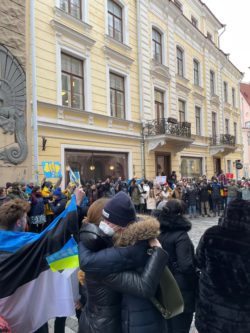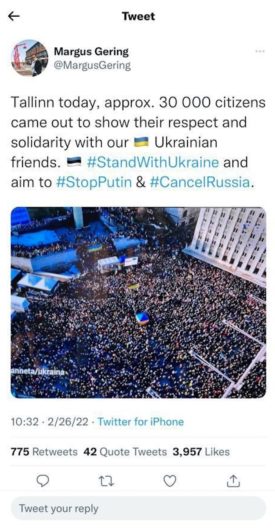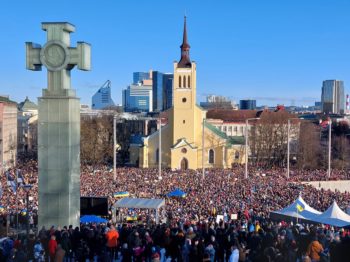As I write this today, less than a week into Russia’s invasion of Ukraine, I’m wearing three hats: those of a digital safety specialist, a proud board member of the US’s National Association for Media Literacy Education (NAMLE) and a digital nomad who loves Estonia, where I’m based this year.

The third hat first, with a little geographical and cultural context. The start of the invasion was felt intensely here, next door to Russia, in this smallest of the Baltic countries (pop. only about 1.3 million), which won its independence so very recently – February 24, 1991. It was not lost on Estonians that this latest Russian invasion of Ukraine began on Estonia’s Independence Day.
Their expression of solidarity with the Ukrainian people this past weekend was inspiring to witness, from the small but heartfelt protest in front of the Russian Consulate in the oldest part of this very digital capital city last Thursday to the protest of some 30,000 Estonians – a significant proportion of the population – Saturday in Freedom Square. There’s a solid historical basis for that feeling of solidarity, from dealing with what, to the Baltic countries, was decades of Russian then Nazi then Russian occupation during and after World War 2 to the fact that Russian language and culture are very much a part of Estonia, and so many Estonians, like so many Ukrainians, are of Russian descent. Almost half (43%) of Estonia’s population are Russian speakers, and they represent Tatar, Ukrainian, Belarusian and other ethnicities in this region.

Complicated, beautiful, sad
In a great story about Tallinn’s annual music festival last October, German news broadcaster DW.com reported that, of the 176 acts from 21 countries, 18 were from Russia, and the story led with four: “a Tatar-Russian electronic hip-hop duo, Icelandic techno-punks Hatari, Estonian-Russian gothic rock band Rainday Station and the decibel-loving New York band A Place To Bury Strangers.” This is our beautiful world now, if we can forget about war for a moment. We need to get back to this, right?
But we can’t even for a moment forget, because what’s happening in Ukraine is heart-breaking for us and people all over Europe – and not just because of concerns that Russia’s aggression could spread. Ukraine’s neighbors are generously welcoming its more than 670,000 refugees (so far), with Poland leading, having taken in 377,000 Ukrainians as of yesterday, the BBC reported.
Media literacy CANNOT be in short supply
Of course we expats are closely following the coverage in our own countries, which brings me to my other two hats. As my mates at NAMLE probably agree, media literacy is needed more now than ever. It is actually a source of safety – digital, emotional and physical – during a war, a pandemic and a climate crisis. For the safety of our children, ourselves, our communities, our identities, mental and physical health, finances, communities, institutions, governments and planet, we need to know if the information we’re taking in is accurate.
But let’s just talk about our children. In the 25 years I’ve been writing about kids and digital media, children’s exposure to graphic images and descriptions of tragic news near and far away has only grown, which may be one explanation (see this and this) for the mental health crisis children and teens in many societies (evidence in the US here).
Each time a major tragedy happens, good advice for how to talk with our children appears in the news media. An article of that sort in the Washington Post stood out to me this week for three reasons….
1. Figuring-it-out-together mode
First, writer Amy Joyce urges parents not just to talk with their children but to take the time to sit with them and ask (I’d add with genuine curiosity) if they can show you where they got that particular bit of information. With younger children, you can try to corroborate it together by looking for other sources of that perspective or data point. Genuine curiosity is just as important with teens and, while they may not be as willing to go into what their sources were, you can challenge them to think critically about where the info came from and about the intentions of its source(s) and also to consider whether it’s appropriate to share – how sharing it might reflect on them.
“Treating this as something you’re figuring out together will keep them from feeling like they have to hide it from you,” Joyce wrote.
2. Role-play the decisionmakers
The second reason why the Post piece stood out to me was its mention of an online game for ages 12+ called “Convene the Council” that families can play to practice figuring out global events together. Created by iCivics (founded in 2009 by Supreme Court Justice Sandra Day O’Connor) and the Council on Foreign Relations, the game is “aimed at showing how the president of the United States makes foreign policy decisions,” Joyce reports. “The Ukraine situation is an ‘extreme example’ of a foreign policy challenge,” one of her sources says, “but playing alongside your child as they worry and wonder about the situation in Eastern Europe can help provide them (and you) with more information about how things work.”
My children are out of the nest now, so I haven’t tried the game, and would love to hear from you in comments what you think of it. But it’s a great idea in any case, and there needs to be a version in the metaverse! Play is a great way to figure things out together, and more knowledge about a situation – accurate knowledge – can ease the anxiety of uncertainty. We fear what we don’t understand, right?
3. Helping others helps everybody
The third reason: The article ends with the wisdom of doing something about the sadness we might feel. While we’re applying our media literacy together, we can ask our children how they might help. “Feeling as if they can have some impact during such a tumultuous time gives them agency and a feeling that they can make a difference,” writes reporter Amy Joyce. It’s good for their mental health, as well as for the people they’re helping. There’s all kinds of research backing that up (examples here and here).

Way back in 2008, a national task force I served on did a very complete review of all the youth online risk research published up to that point (there was already a lot because the field started in the US around 2000). One of its findings was that the most common online risk most children and young people face is social-emotional. It has more to do with mental than physical safety and wellbeing. That is still true for the vast majority of young people, and they, like us, are exposed to more and more media – including more visual media. We also know that negative media of all kinds affect people’s mental health, and media literacy can help with that. Media literacy education at home and school is needed by people of all ages more than ever, because of the state of our mental health and the state of our media. We need to figure this out together.
Related links
- About “doom-scrolling” and “protecting the brain against bad news” from the Canadian Medical Association Journal
- How to talk with our kids about the news: NPR too pulled together ideas for this from excellent sources. This article also ends with parents and kids “taking positive action together,” and I loved that they included Fred Rogers’ “look for the helpers.” That was the message I held on to and wrote about after the terrible Sandy Hook school shooting in 2012 – what “Mr. Rogers” told his young TV viewers his mom had taught him.
- Two more stories from Estonia: one about two kids in Tallinn, Estonia, who are (with their parents) acting on their concerns for the Ukrainian people and “>one about what Estonia’s sending Ukraine. This country allocated 1.3 million euros for refugees coming here, after already committing to send more Javelin antitank missiles (an additional shipment), antiaircraft munitions, protective gear, and food and medical equipment, tweeted Margus Gering, deputy head of mission in the Estonian Embassy in Kyiv.
- ERR.ee, a major source of English-language news in Estonia and the Baltic Times for all three Baltic countries, all of which are members of NATO (North Atlantic Treaty Organization)
- According to the Baltic Times, former Estonian President Kersti Kaljulaid said “it is ironic, in a way, that Estonia’s accession to NATO was guaranteed not only by its firm will to be an ordinary European state, but also by the firm conviction of many of Estonia’s allies today that Russia would never pose a threat again. ‘However [Kaljulaid said last Thursday], our haste and rush were fueled by the knowledge that a day could come when Russia is once again a threat to its neighbors. This day came in Georgia in 2008, in Ukraine in 2014, and today, on the birthday of the Republic of Estonia, this day has come again in Ukraine. This is the day when intolerable evil was thrown against peaceful people longing for freedom’.” She said Estonia has “a moral obligation to help those who have not yet succeeded in joining NATO.”

[…] Media literacy and an invasion: The view from Estonia – NetFamilyNews.org […]